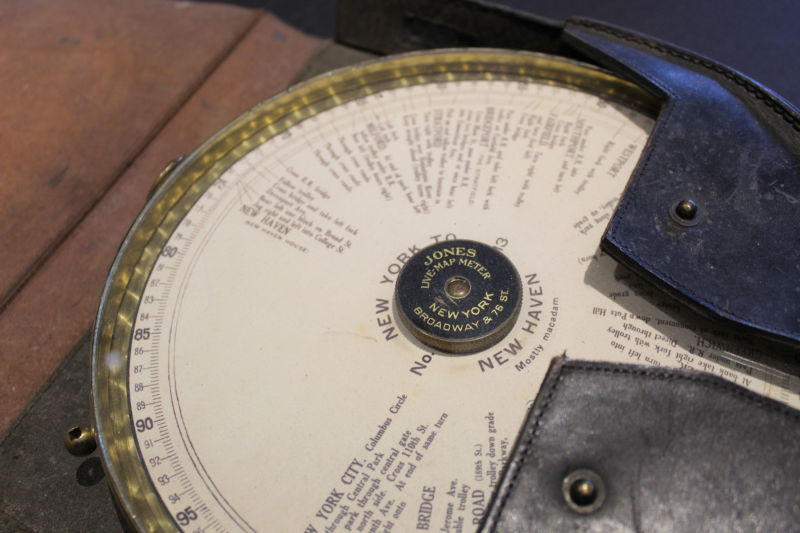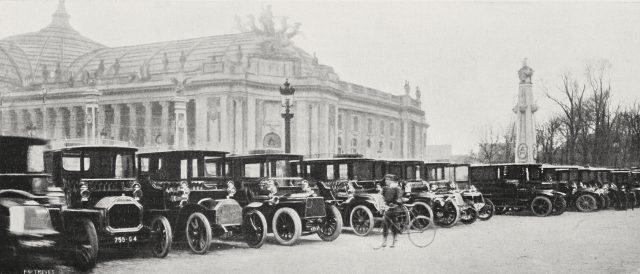Turn-by-turntables: How drivers got from point A to point B in the early 1900s

Seal Cove Auto Museum
It’s easy to take modern GPS navigation for granted; it’s no longer a novelty. Not only is it offered on the dashboard of your car, it’s on every smartphone in everyone’s purse or pocket. But if you think in-car navigation systems started with Garmin in 1991, guess again.
The more savvy amateur car historians might think in-car navigation began with the Etak Navigator. The brainchild of engineer Stan Honey and financier Nolan Bushnell (the cofounder of Atari), Etak was launched in 1985 without use of the US Military’s Global Positioning System—the addition of GPS wouldn’t happen for another decade. Yet Etak paved the way for the systems that followed, using digitized maps stored on cassette tapes since they could resist a bumpy car ride or the heat of a car interior on a hot day. Information was posted on a vector-based CRT screen. Each tape held 3.5MB of map data. A windshield-mounted electronic compass mated to wheel sensors to determine the vehicle’s speed and direction. Two models were offered: the 700, with a 7-inch screen for $1,595, and the 450, with a 4.5-inch screen for $1,395. Map cassettes cost $35 each. Initially offered only with San Francisco-area maps, Etak soon offered other major metro areas, with installation provided by local car stereo and cell phone shops.
Initially successful, sales inevitably slumped. In 1989, Etak was purchased by News Corporation for $25 million, followed by Sony Corporation and others before being absorbed into Tom Tom.
But finding your way in the United States is far easier today than it once was. For most of the nation’s history, driving somewhere new took time, luck, and patience—and systems like the Etak Navigator helped change that fact. But Etak, like modern GPS systems, was also far from the first portable in-car navigation system.
Early roadmaps
Maps of America’s largest cities first appeared in the 18th century, and—incredibly—so did the first road atlas. In 1789, “The Survey of the Roads of the United States of America,” by Christopher Colles of New York mapped roads from Williamsburg, Virginia, to Albany, New York. However, it didn’t come as a complete volume—it was instead subscription based. Subscribers were expected to gather the plates together into a coherent atlas. Colles printed 83 plates in three years, each containing two or three maps. But the business faltered for one simple reason: there was little use for road maps in the United States in the late 1700s.

But the arrival of the automobile in 1895 changed all that.
No longer restricted to a railroad or stagecoach schedule, the automobile promised the freedom to go anywhere, any time. Pretty soon, it became obvious that finding your way from town to town was extremely difficult, leading to the creation of “The Official Automobile Blue Book.” Unrelated to the modern-day Blue Book, this driver’s encyclopedia directed motorists from one place to another using mileage between towns and mileage between each instruction. It also listed local landmarks, state motor laws, hotels, repair shops, recharging stations, and ferry and steamship schedules and rates. The guide’s popularity swelled when AAA became its sponsor in 1906.
But the guide had its competitors.
In 1907, mapmaker Rand McNally assumed publication of the Photo-Auto Guides, which combined maps and photos with arrows to indicate turns. There was also Thomas Bros. Maps, established in 1915 in Oakland, California, which employed a unique page-by-page grid system of mapping that eliminated the need for a folding map. Clearly Rand McNally loved it. By 1924, Rand McNally’s Auto Chum appears, known today as the Rand McNally Road Atlas. There were other guides as well, including The Automobile Green Book from the Automobile Legal Association of Massachusetts; King’s Official Route Guide by Sidney J. King of Chicago; and the Interstate Automobile Tourists’ Guide by F. S. Blanchard and Company of Worcester, Massachusetts, among others.
While these guide books were essential, they had their limitations. Many used local landmarks in their instructions, such as “turn left around drug store.” But if such landmarks disappeared, discerning where to turn proved puzzling. Perhaps this is why the folding paper road map became so popular. Gulf Oil, founded by Pittsburgh’s Mellon family in 1901 to exploit Texas oil, is credited as creating it as a promotional device for its new drive-in gas stations, the first of which opened in Pittsburgh in 1913. (Most major oil companies followed, continuing until the OPEC oil embargoes of the 1970s. These days, state governments print road maps.)

The duty cars in front of the Grand Palais at the 1906 Paris Motor Show.
Credit: Getty Images / M Branger, from L'Illustrazione Italiana / DEA / BIBLIOTECA AMBROSIANA.The first navigation systems
This illustration from the Jones Live Map patent shows the flexible shaft cable that hooked it up to the front wheel.
USPTO
An original Jones Live Map in its leather case.
Seal Cove Auto Museum
The Jones Live Map was an early 20th century attempt at turn-by-turn navigation.
Seal Cove Auto Museum
The fastest way from New York to New Haven, Conn. Mostly paved!
Seal Cove Auto Museum
A close-up of the New York to New Haven disc.
Seal Cove Auto Museum
You'd need to start from a specific point for the Live Map to work.
Seal Cove Auto Museum
Some time later, you'll end up outside of New Haven House.
Seal Cove Auto Museum
Given Americans’ longtime fascination with mechanizing every facet of American life, it’s not surprising that experimental navigation aids soon appeared. These are sort of prehistoric ancestors of today’s navigation systems. One of the earliest and most successful first appeared in 1909: the Jones Live-Map.
Born in Saratoga, New York, in 1876, Joseph W. Jones was an engineer who interned with audio pioneer Emile Berliner, whose invention of the flat disc record eclipsed Thomas Edison’s cylindrical discs in the marketplace. Jones improved the method for engraving discs onto a wax master disc, which he received a patent for in 1901. Selling the patent to the Columbia Graphophone Company for $25,000, Jones used the money to establish his new Jones Instrument Company, which comprised a factory in Rochester, New York, and a new four-story showroom in New York City. That showroom opened in 1907 at the northeast corner of Broadway and 76th St., then the heart of Manhattan’s Automobile Row.
It was Jones who had invented the “Speed-O-Meter,” a device he installed on a Winton for a 1901 endurance run from New York to Buffalo. He applied for a patent in 1903, which was issued the following year. It used a flexible shaft cable and a gear-driven attachment to a front wheel, a set-up Jones would use in another invention, the “Combined Road-Map and Odometer.”
The Live Map was a glass-enclosed brass dial attached to the outer edge of the driver's side of the car and linked via a cable to a car’s odometer. Before leaving on your drive, you would purchase one of the company’s 8-inch paper discs with a trip’s directions, put together by The Touring Club of America. Each disc contained a trip’s mileage on the edge of the disc, with each tick mark symbolizing one mile, and supplementary tick marks for every fifth of a mile. Directions were printed alongside key mileage points like spokes on a wheel, describing road surfaces (paved or dirt), intersections, and rail crossings.
The disc was placed on the dial’s turntable. The driver would put the disc in the machine at the trip’s starting point. As the driver progressed, the disc rotated proportionally to your car’s speed, telling you what to do, what to look for, and where to turn. Each disc covered about 100 miles, at which point you pulled over and stopped to replace the disc with the next one. Of course, the device wasn’t accurate if drivers didn’t precisely follow the centerline of the road. So Joseph’s brother Ernest, to keep the mileage exact, introduced an improvement for 1913 that reduced the amount of rotation transmitted to the device if the driver was steering erratically.
The meter cost $75 and included 12 disks. Additional disks cost 25 cents each, or you could purchase multiple discs for 15 cents. An advertisement in the Saturday Evening Post boasted that, "To have it with you is like having in your car a man who knows every road, every corner, every crossing, every landmark, every puzzling fork and crossroad in the entire world.”
By 1919, Jones offered more than 500 routes from New York to California, but Jones was not alone in this emerging market. In fact, Jones' device was rejected by the US Patent Office five times for its similarities to other devices.
Listing image by Getty Images / M Branger, from L'Illustrazione Italiana / DEA / BIBLIOTECA AMBROSIANA
from Hacker News https://ift.tt/2Fq8ZFO